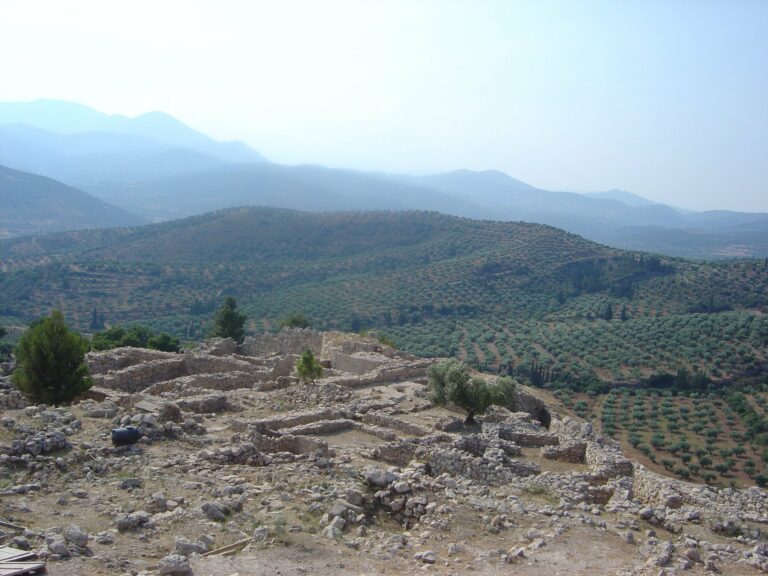Exploring Mycenae’s local cuisine is an adventure for the palate. The city, steeped in ancient history, offers mouthwatering dishes like the juicy grilled meat skewers known as souvlaki. Another must-try is moussaka, a traditional casserole with layers of eggplant, seasoned meat, and béchamel sauce.
As you taste Mycenae’s food scene, the sweet treats will catch your attention, particularly the honey-drenched pastries filled with nuts, called baklava. For those who prefer savory options, the experience of tasting meats encased in fluffy pita bread is unmissable.
These culinary delights are not just food; they represent Mycenae’s rich cultural heritage and the fusion of flavors that has evolved over centuries.
Let’s dive into this flavorful journey and discover the tastes of Mycenae.
Souvlaki: Grilled Meat Skewers
Souvlaki, the savory grilled meat skewers, is a culinary delight deeply rooted in Mycenae’s local gastronomy. The key to its irresistible taste is a skillful grilling technique, which hinges on the precise application of heat and accurate timing. Typically, pork or chicken is chosen for souvlaki, and it’s soaked in a marinade that sings with the harmonious notes of olive oil, lemon juice, garlic, and a carefully chosen mixture of herbs and spices. The meat is then expertly threaded onto skewers and grilled over a direct flame, turning skillfully to reach that ideal state: moist and tender inside with a lightly charred, crisp exterior.
This delicious dish varies intriguingly across Greece’s many regions, with each area infusing it with local flair. Some regions might favor lamb or beef over the more common pork or chicken. A marinade in one locale could have a dash of yogurt or vinegar for an extra zesty twist. The spices, too, differ, with each area boasting its own signature concoction, offering a spectrum of flavors to delight diverse tastes.
More than just a meal, souvlaki represents a culinary tradition that captures the spirit of conviviality. Grilling these skewers is a communal event, a chance to revel in the great outdoors and cherish moments with family and friends. It’s about celebrating life’s simplest joys: delectable food, warm companionship, and the pleasure of savoring each morsel.
When you’re next in Mycenae or elsewhere in Greece, don’t miss out on the exceptional taste of souvlaki—it’s a true homage to the art of dining.
Moussaka: Layered Eggplant and Meat Dish
Moussaka: A Staple of Greek Cuisine
Moussaka is a delightful Greek dish known for its layers of juicy eggplant and flavorful meat. It’s a staple of Mediterranean cooking and a highlight of Greek food culture, essential for anyone exploring the historical region of Mycenae.
Here’s why moussaka deserves a place on your list of must-try foods:
- Hearty and Satisfying: Moussaka’s combination of soft eggplant, spiced ground meat, and a rich béchamel sauce offers a comforting and luxurious meal.
- Flavorful Blend: The dish’s use of aromatic garlic, onions, sweet cinnamon, and warming nutmeg creates a sophisticated array of tastes.
- Cydbwysedd Maeth: The ingredients provide a well-rounded meal, with protein from the meat and nutrients from the eggplant.
- Addasrwydd: Though traditional moussaka includes eggplant and meat, there are other versions with potatoes, zucchini, or lentils for those preferring a vegetarian option.
- Mewnwelediad Diwylliannol: Enjoying moussaka is more than eating; it’s an exploration of Greek culture and its deep-rooted food traditions.
For anyone interested in diverse flavors or cultural culinary exploration, moussaka is a dish that promises a memorable experience. It’s a cornerstone of Greek dining that you shouldn’t pass up when visiting Mycenae.
Baklava: Sweet Pastry With Nuts and Honey
Baklava, a delightful sweet from the Mediterranean, captivates with layers of phyllo dough, aromatic nuts, and honey. This pastry boasts a storied past, dating back to the Byzantine Empire, revered as a treat for the elite on grand occasions. Its journey through the Mediterranean and the Middle East has embedded it in the culinary traditions of these regions.
Key to baklava’s charm are the local twists that define its character. In Greece, the pastry is crafted with fine phyllo sheets, a medley of ground almonds or walnuts, and drenched in honey syrup. Turkish baklava is famed for its gossamer-thin layers, often perfumed with rose or orange blossom water. Lebanese baklava distinguishes itself with pistachios and cashews for a unique taste.
Baklava’s adaptability means there’s a version for every palate. Whether you’re drawn to almonds, pistachios, or a nut blend, baklava is a testament to the confectioner’s art. Its enduring popularity and the myriad interpretations it has spurred underscore its culinary importance. Sampling baklava is an essential experience in Mycenae, offering a taste of its long-standing allure.
Spanakopita: Spinach and Feta Cheese Pie
Spanakopita, a beloved Greek dish, pairs the lively tastes of spinach and feta cheese within a crisp phyllo pastry. This classic recipe has been cherished across Greek households for ages. While each family might add their own twist, the core components—spinach, feta cheese, onions, aromatic herbs, and the phyllo dough—remain consistent.
Incorporating spinach and feta into meals can be quite beneficial for health. Spinach comes loaded with essential nutrients like vitamins A, C, and K, and it’s a good source of iron and calcium. Feta cheese offers a valuable supply of protein along with vital minerals such as calcium and phosphorus.
Spanakopita can be enjoyed in various ways, whether as a quick bite, a starter, or the main attraction on the dining table. The pastry’s flaky texture perfectly complements the hearty and flavorful spinach-feta mix, offering a satisfying experience.
On your next trip to Mycenae, don’t miss trying this exquisite example of Greek cuisine.
Gyro: Savory Meat Wrapped in Pita Bread
Gyro, a cornerstone of Greek culinary tradition, offers the simple pleasure of seasoned meat enveloped in soft pita bread. This dish has found its way from the bustling streets of Greece to the global stage, where it’s been adapted to local tastes. In the United States, gyros typically feature lamb or beef, whereas chicken or fish may be used in certain Middle Eastern nations. Each regional twist incorporates distinct spices, broadening the gyro’s appeal.
Pita bread, a staple for the gyro, consists of flour, water, yeast, and a pinch of salt. Opting for pita bread means choosing a healthier vessel for the tasty filling; it’s lower in fat and calories compared to many bread alternatives. Pita also provides complex carbohydrates for sustained energy, keeping hunger at bay. Its fiber content supports digestive health. Thus, the gyro isn’t only a treat for the tastebuds but also a considerate choice for well-being.
The benefits of gyro are further highlighted by its preparation. Skilled cooks typically season the meat with herbs like oregano and thyme, and often add a tangy sauce such as tzatziki, made from yogurt, cucumber, and garlic, to enhance the flavor. The result? A delightful combination that nurtures the body and delights the palate.
Loukoumades: Deep-Fried Dough Balls With Honey Syrup
Loukoumades, a delightful Greek sweet treat, are crispy deep-fried dough balls drenched in aromatic honey syrup. This classic dessert from Greece is a favorite among locals and tourists alike, often found in street food markets. With a pleasing golden crust and a tender center, loukoumades are sure to fulfill any craving for sweets.
Here are five compelling reasons to give loukoumades a try:
- Exquisite Taste: When you bite into a loukoumade, the crunch of the fried dough gives way to a soft core, all unified by the sweet touch of honey. This contrast in textures and the harmony of flavors are what make the dessert exceptionally tempting.
- Arwyddocâd Hanesyddol: Loukoumades are steeped in Greek culinary traditions, dating back centuries. Savoring this dessert is a way to connect with the storied food culture of Greece.
- Customizable: There’s a loukoumade for every palate. They can be savored plain or embellished with cinnamon, a dusting of powdered sugar, or a sprinkle of nuts. The flexibility in how they can be served means they’re a versatile choice for any dessert lover.
- Communal Joy: Sharing loukoumades with friends and family turns eating into a communal joy. They’re the perfect centerpiece for social gatherings, whether at a vibrant street market or around a homely dining table.
- A Treat for Yourself: Indulging in a loukoumade is a moment of sheer pleasure. It’s a sweet pause in the day that everyone deserves.
Loukoumades are more than just a dessert—they’re an experience. Don’t pass up the opportunity to enjoy the rich flavors and deep-rooted history of this exquisite Greek confection, a highlight of Mycenae’s local cuisine.









